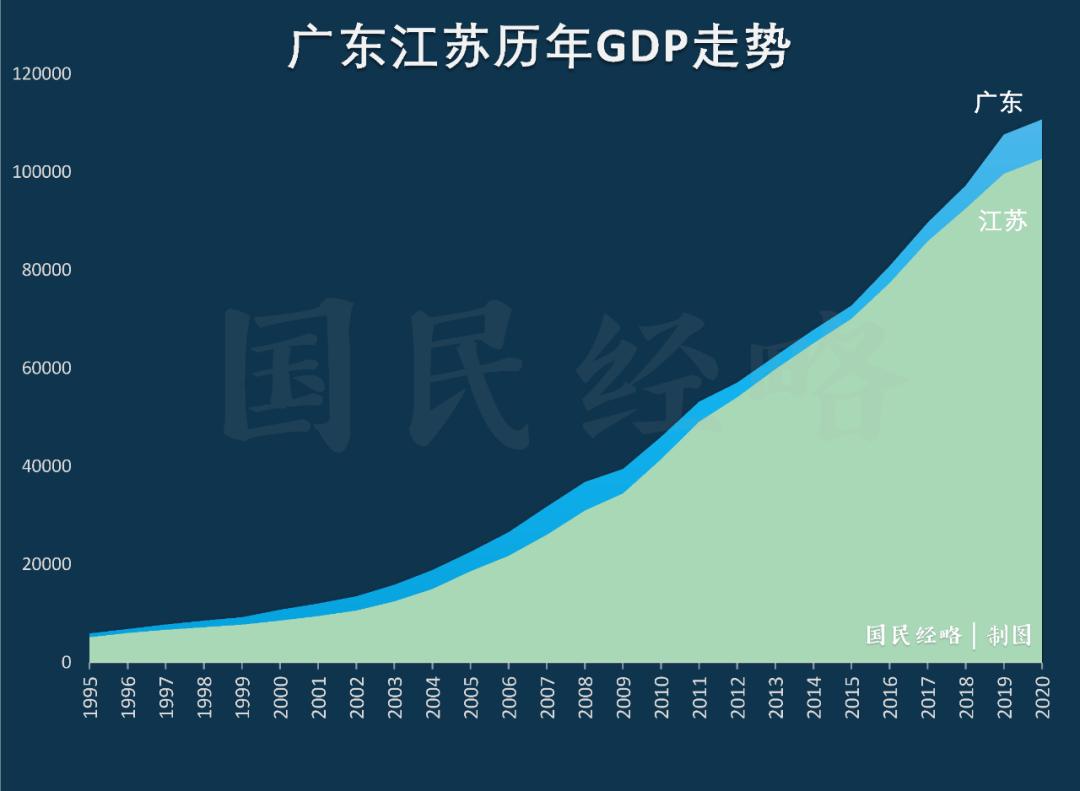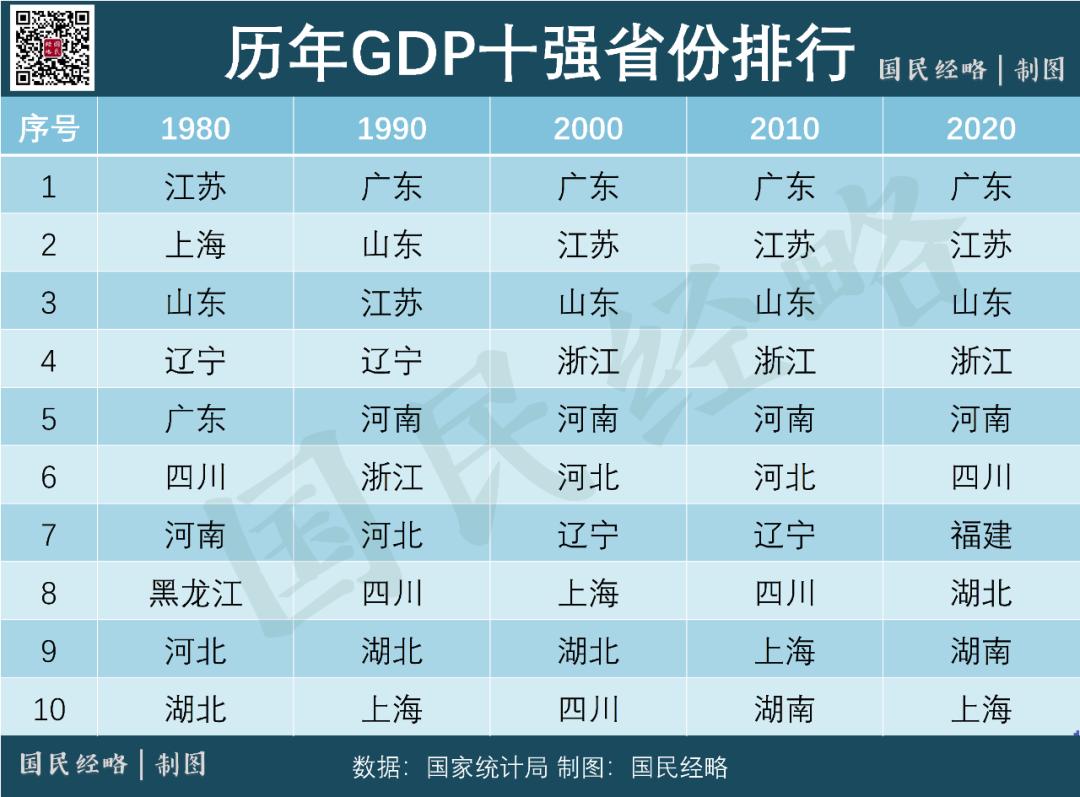In 2020, the GDP rankings of provinces and cities in mainland China.
The original Kaifeng national history is included in the topic # 84 Reading Cities
Wen | Kaifeng
In the past year, the provincial economic structure has undergone tremendous changes.
In 2020, under the impact of the epidemic, China’s economy turned positive against the trend and became the only major economy with positive growth. Due to the different impact of the epidemic, the economic development of various provinces and cities is different, and the provincial economy has undergone tremendous changes.
This is the economic data of 31 provinces in China in 2020:
First, both Guangdong and the Soviet Union have exceeded 10 trillion yuan, but Guangdong’s leading edge is still expanding.
In 2020, Guangdong’s GDP was 11.07 trillion, and Jiangsu’s was 10.27 trillion, both of which broke 10 trillion.
The total economic output of 10 trillion yuan exceeds more than 90% of the countries in the world. Guangdong’s GDP has surpassed Russia and South Korea, while Jiangsu’s GDP has also surpassed Australia and Spain. This is in "Catch up with Russia! How strong is China’s largest economic province? ".
Guangdong and Jiangsu are both strong economies, but their development advantages are different.
The strength of Guangdong lies in its all-round strength. It is not only the largest economic province, but also the most populous province, and it is also the largest province in industry, foreign trade, finance and pensions. It is also the province with the largest financial contribution and central pension adjustment.
The strength of Jiangsu lies in its balanced development. There are 4 trillion cities in Jiangsu, and the GDP of all cities is above 300 billion, all of which rank among the top 100 in China, and it is also the only province where all cities are among the top 100.

Guangdong’s shortcoming lies in uneven development, and there is a clear gap between Guangdong, East and West and the Pearl River Delta. Jiangsu’s shortcomings lie in the high aging rate, insufficient population appeal and too traditional industrial structure.
In addition, the gap between Guangdong and the Soviet Union continues to widen. In 2020, Guangdong will lead Jiangsu by 804.2 billion yuan, equivalent to the economic aggregate of more than one Changzhou.
Secondly, Fujian overtook Hubei, Hebei overtook Beijing, Jiangxi overtook Liaoning and Guizhou overtook Shanxi and Inner Mongolia.
The biggest change in the provincial structure in 2020 is the sudden emergence of Fujian, Jiangxi and Guizhou.
It is expected that Fujian will overtake Hubei.
Hubei was severely hit by the epidemic, with GDP falling by 5% for the whole year, while Fujian maintained a positive growth of 3.3%. As soon as it entered and retreated, Hubei was surpassed by Fujian for the first time.
It is worth mentioning that Fujian is also a province that has harvested two trillion GDP cities within one year. Quanzhou and Fuzhou are among the trillion clubs, which is a highlight moment.
However, the impact of the epidemic in Hubei has already subsided, and the economy will rebound strongly in 2021. There should be no suspense for Hubei’s GDP to return to the position of the seventh province in China.
Jiangxi overtook Liaoning.
Although Jiangxi has a low sense of existence, its growth rate ranks among the top in the country in recent years, surpassing Guangxi and Liaoning successively and moving forward steadily.
The biggest problem in Jiangxi is the lack of star cities, and the GDP of Nanchang, the provincial capital, is still around 600 billion. Around Nanchang, a "trillion GDP urban agglomeration around Nanchang" has been formed, and it is imperative to make Nanchang bigger. This is discussed in detail in the article The Latest Trillion GDP City.

Guizhou is another typical example of its rise.
In 2020, Guizhou’s GDP was 1.78 trillion yuan, surpassing Inner Mongolia and Shanxi in one fell swoop and ranking among the top 20.
In recent years, with the help of fixed assets investment and industrial blessing, Guizhou’s economic growth rate has long been in the forefront of the country. In 2020, the actual growth rate of Guizhou is 4.5%, second only to Tibet, leading the major provinces.
On the contrary, Inner Mongolia and Shanxi are both resource-based provinces. In recent years, traditional industries have been affected by the big environment, which has dragged down the economic growth.
Third, the development momentum of the central and western provinces is good, and the growth rate is generally higher than that of coastal areas.
In 2020, the 11 provinces with the highest actual growth rate are Tibet, Guizhou, Yunnan, Anhui, Hebei, Chongqing, Gansu, Ningxia, Sichuan, Hunan and Jiangxi.
Of these provinces, 9 are located in the central and western regions, with only one eastern province in Anhui and one northern province in Hebei.
One reason for the rapid economic growth in the central and western provinces is that they are relatively unaffected by the epidemic. These provinces are deeply inland, and their foreign trade industries are not as good as those in coastal areas, so they are relatively less affected by the global epidemic situation and international trade disputes.
Another reason is that these provinces are still in the stage of rapid catch-up, and they can quickly boost the economy with the help of large-scale fixed investment. However, the traditional infrastructure investment in the eastern region is relatively perfect, and there is little room for fixed investment to contribute to economic growth.
In addition, in the era of internal circulation, the central and western regions have gained certain advantages.
The populous provinces in the central and western regions not only have the advantage of labor dividend, but also have the support of huge consumer market, which is an important bearing place of "internal circulation".
Fourth, in the past 40 years, the top ten provinces have undergone earth-shaking changes: the northeastern provinces have disappeared and the eastern provinces have risen strongly.
In 1980, the top 10 economic provinces in China were Jiangsu, Shanghai, Shandong, Liaoning, Guangdong, Sichuan, Henan, Heilongjiang, Hebei and Hubei.
At that time, Liaoning and Heilongjiang in Northeast China were among the top ten, and their economic strength surpassed that of southeast provinces such as Zhejiang and Fujian, and Hebei’s comprehensive strength was in the forefront.

In 2020, the top 10 economic provinces in China are Guangdong, Jiangsu, Shandong, Zhejiang, Henan, Sichuan, Fujian, Hubei, Hunan and Shanghai.
Over the past 40 years, only Guangdong, Jiangsu, Shandong, Henan, Sichuan, Hubei and Shanghai have been among the top ten, with Zhejiang, Fujian and Hunan coming from behind.
Northeast provinces have disappeared from the top 10 list.
Original title: "GDP Rankings of Provinces and Cities in China in 2020"
Read the original text